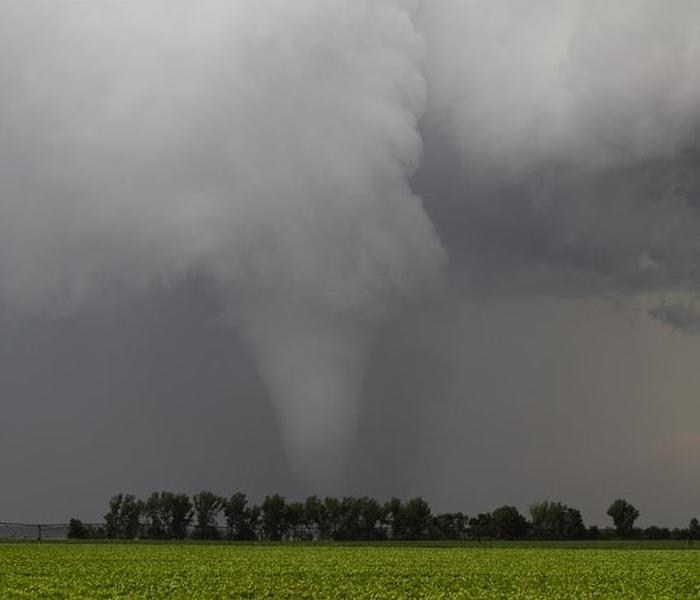What Do You Know About Tornadoes?
5/6/2016 (Permalink)
Although tornadoes occur in many parts of the world, these destructive forces of nature are found most frequently in the United States east of the Rocky Mountains during the spring and summer months. In an average year, 800 tornadoes are reported nationwide, resulting in 80 deaths and over 1,500 injuries. A tornado is defined as a violently rotating column of air extending from a thunderstorm to the ground. The most violent tornadoes are capable of tremendous destruction with wind speeds of 250 mph or more. Damage paths can be in excess of one mile wide and 50 miles long. Once a tornado in Broken Bow, Oklahoma, carried a motel sign 30 miles and dropped it in Arkansas!
What Causes Tornadoes?
Thunderstorms develop in warm, moist air in advance of eastward-moving cold fronts. These thunderstorms often produce large hail, strong winds, and tornadoes. Tornadoes in the winter and early spring are often associated with strong, frontal systems that form in the Central States and move east. During the spring in the Central Plains, thunderstorms frequently develop along a "dryline," which separates very warm, moist air to the east from hot, dry air to the west. Tornado-producing thunderstorms may form as the dryline moves east during the afternoon hours.
How Do Tornadoes Form?
Before thunderstorms develop, a change in wind direction and an increase in wind speed with increasing height creates an invisible, horizontal spinning effect in the lower atmosphere. Rising air within the thunderstorm updraft tilts the rotating air from horizontal to vertical. An area of rotation, 2 - 6 miles wide, now extends through much of the storm. Most strong and violent tornadoes form within this area of strong rotation
Weak Tornadoes
- 69% of all tornadoes
- Less than 5% of tornado deaths
- Lifetime 1-10+ minutes
- Winds less than 110 mph
- 29% of all tornadoes
- Nearly 30% of all tornado deaths
- May last 20 minutes or longer
- Winds 110-205 mph
- Only 2% of all tornadoes
- 70% of all tornado deaths
- Lifetime can exceed 1 hour
- Winds greater than 205 mph
Tornado Myths:
MYTH: Areas near rivers, lakes and mountains are safe from tornadoes.
FACT: No place is safe from tornadoes. In the late 1980's, a tornado swept through Yellowstone National Park leaving a path of destruction up and down a 10,000 ft. mountain.
MYTH: The low pressure with a tornado causes buildings to "explode" as the tornado passes overhead.
FACT: Violent winds and debris slamming into buildings cause most structural damage.
MYTH: Windows should be opened before a tornado approaches to equalize pressure and minimize damage.
FACT: Opening windows allows damaging winds to enter the structure. Leave the windows alone; instead, immediately go to a safe place.
Tornadoes can occur at any time of the year
- In the southern states, peak tornado occurrence is in March through May, while peak months in the northern states are during the summer.
- Note, in some states, a secondary tornado maximum occurs in the fall.
- Tornadoes are most likely to occur between 3 and 9 p.m. but have been known to occur at all hours of the day or night.
- The average tornado moves from southwest to northeast, but tornadoes have been known to move in any direction. The average forward speed is 30 mph but may vary from nearly stationary to 70 mph.
- The total number of tornadoes is probably higher than indicated in the western states. Sparse population reduces the number reported.
- SEVERE THUNDERSTORM WATCH: Severe thunderstorms are possible in your area.
- SEVERE THUNDERSTORM WARNING: Severe thunderstorms are occurring.
- TORNADO WATCH: Tornadoes are possible in your area. Remain alert for approaching storms.
- TORNADO WARNING: A tornado has been sighted or indicated by weather radar. If a tornado warning is issued for your area and the sky becomes threatening, move to your pre-designated place of safety.
- Dark, often greenish sky
- Wall cloud
- Large hail
- Loud roar; similar to a freight train
Some tornadoes are clearly visible while others are obscured by rain or nearby low-hanging clouds. It's Up to YOU!
Each year, many people are killed or seriously injured by tornadoes despite advance warning. Some did not hear the warning while others received the warning but did not believe a tornado would actually affect them. This preparedness information, combined with timely severe weather watches and warnings, could save your life in the event a tornado threatens your area. After you have received the warning or observed threatening skies, YOU must make the decision to seek shelter before the storm arrives. It could be the most important decision you will ever make.





 24/7 Emergency Service
24/7 Emergency Service
